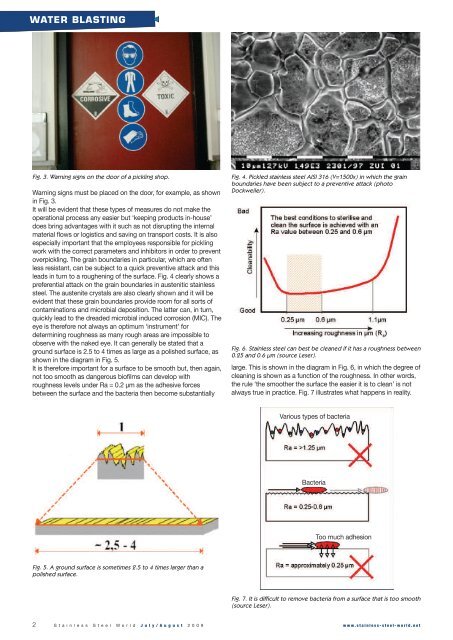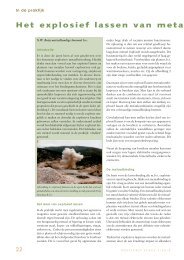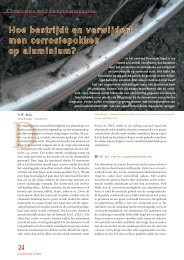Water blasting of stainless steel - Innomet BV
Water blasting of stainless steel - Innomet BV
Water blasting of stainless steel - Innomet BV
Create successful ePaper yourself
Turn your PDF publications into a flip-book with our unique Google optimized e-Paper software.
WATER BLASTING<br />
Fig. 3. Warning signs on the door <strong>of</strong> a pickling shop. Fig. 4. Pickled <strong>stainless</strong> <strong>steel</strong> AISI 316 (V=1500x) in which the grain<br />
boundaries have been subject to a preventive attack (photo<br />
Warning signs must be placed on the door, for example, as shown<br />
in Fig. 3.<br />
It will be evident that these types <strong>of</strong> measures do not make the<br />
operational process any easier but ‘keeping products in-house’<br />
does bring advantages with it such as not disrupting the internal<br />
material flows or logistics and saving on transport costs. It is also<br />
especially important that the employees responsible for pickling<br />
work with the correct parameters and inhibitors in order to prevent<br />
overpickling. The grain boundaries in particular, which are <strong>of</strong>ten<br />
less resistant, can be subject to a quick preventive attack and this<br />
leads in turn to a roughening <strong>of</strong> the surface. Fig. 4 clearly shows a<br />
preferential attack on the grain boundaries in austenitic <strong>stainless</strong><br />
<strong>steel</strong>. The austenite crystals are also clearly shown and it will be<br />
evident that these grain boundaries provide room for all sorts <strong>of</strong><br />
contaminations and microbial deposition. The latter can, in turn,<br />
quickly lead to the dreaded microbial induced corrosion (MIC). The<br />
eye is therefore not always an optimum ‘instrument’ for<br />
determining roughness as many rough areas are impossible to<br />
observe with the naked eye. It can generally be stated that a<br />
ground surface is 2.5 to 4 times as large as a polished surface, as<br />
shown in the diagram in Fig. 5.<br />
It is therefore important for a surface to be smooth but, then again,<br />
not too smooth as dangerous bi<strong>of</strong>ilms can develop with<br />
roughness levels under Ra = 0.2 µm as the adhesive forces<br />
between the surface and the bacteria then become substantially<br />
Fig. 5. A ground surface is sometimes 2.5 to 4 times larger than a<br />
polished surface.<br />
Dockweiler).<br />
Fig. 6. Stainless <strong>steel</strong> can best be cleaned if it has a roughness between<br />
0.25 and 0.6 µm (source Leser).<br />
large. This is shown in the diagram in Fig. 6, in which the degree <strong>of</strong><br />
cleaning is shown as a function <strong>of</strong> the roughness. In other words,<br />
the rule ‘the smoother the surface the easier it is to clean’ is not<br />
always true in practice. Fig. 7 illustrates what happens in reality.<br />
Various types <strong>of</strong> bacteria<br />
Bacteria<br />
Too much adhesion<br />
Fig. 7. It is difficult to remove bacteria from a surface that is too smooth<br />
(source Leser).<br />
2 S t a i n l e s s S t e e l W o r l d J u l y / A u g u s t 2 0 0 9 w w w . s t a i n l e s s - s t e e l - w o r l d . n e t





